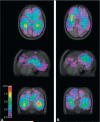Epilepsy and brain tumors
- PMID: 26948360
- PMCID: PMC4803433
- DOI: 10.1016/B978-0-12-802997-8.00016-5
Epilepsy and brain tumors
Abstract
Seizures are common in patients with brain tumors, and epilepsy can significantly impact patient quality of life. Therefore, a thorough understanding of rates and predictors of seizures, and the likelihood of seizure freedom after resection, is critical in the treatment of brain tumors. Among all tumor types, seizures are most common with glioneuronal tumors (70-80%), particularly in patients with frontotemporal or insular lesions. Seizures are also common in individuals with glioma, with the highest rates of epilepsy (60-75%) observed in patients with low-grade gliomas located in superficial cortical or insular regions. Approximately 20-50% of patients with meningioma and 20-35% of those with brain metastases also suffer from seizures. After tumor resection, approximately 60-90% are rendered seizure-free, with most favorable seizure outcomes seen in individuals with glioneuronal tumors. Gross total resection, earlier surgical therapy, and a lack of generalized seizures are common predictors of a favorable seizure outcome. With regard to anticonvulsant medication selection, evidence-based guidelines for the treatment of focal epilepsy should be followed, and individual patient factors should also be considered, including patient age, sex, organ dysfunction, comorbidity, or cotherapy. As concomitant chemotherapy commonly forms an essential part of glioma treatment, enzyme-inducing anticonvulsants should be avoided when possible. Seizure freedom is the ultimate goal in the treatment of brain tumor patients with epilepsy, given the adverse effects of seizures on quality of life.
Keywords: anticonvulsant; epilepsy; glioma; glioneuronal tumor; meningioma; metastasis; outcome; seizure.
© 2016 Elsevier B.V. All rights reserved.
Figures

References
-
- Amstutz U, Shear NH, Rieder MJ, et al. Recommendations for HLA-B*15:02 and HLA-A*31:01 genetic testing to reduce the risk of carbamazepine-induced hypersensitivity reactions. Epilepsia. 2014;55:496–506. - PubMed
-
- Anderson GD, Lin YX, Berge C, et al. Absence of bleeding complications in patients undergoing cortical surgery while receiving valproate treatment. J Neurosurg. 1997;87:252–256. - PubMed
-
- Aronica E, Leenstra S, van Veelen CW, et al. Glioneuronal tumors and medically intractable epilepsy: a clinical study with long-term follow-up of seizure outcome after surgery. Epilepsy Res. 2001;43:179–191. - PubMed
-
- Auriel E, Landov H, Blatt I, et al. Quality of life in seizure-free patients with epilepsy on monotherapy. Epilepsy Behav. 2009;14:130–133. - PubMed
-
- Avila E. Tumor Associated Epilepsy. In: Lichtor T, editor. Clinical Management and Evolving Novel Therapeutic Strategies for Patients with Brain Tumors. InTech; New York, NY: 2013.
Publication types
MeSH terms
Grants and funding
LinkOut - more resources
Full Text Sources
Other Literature Sources
Medical
Research Materials

